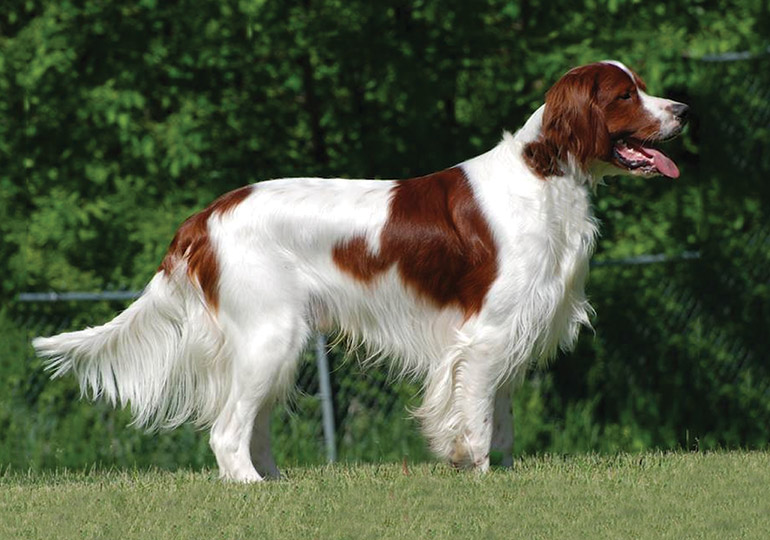
GROUP 3 - GUNDOGS
It is not clear when the Irish Red and White Setter first appeared as a breed. However, there is reference to: ‘Spaniels established in England, mostly white
with red patches’ by the 14th century.
In the late 1800s, Red and White Setters outnumbered solid Red Setters. However,by the 1920s the Irish Red and White almost faced extinction and it was decided to revive the breed in its homeland. By 1944, the breed had been re-established. It is still relatively rare in Australia, however, its presence is growing.
The Irish Red and White Setter has a powerful, athletic body, broad head and a feathered and tapered tail. It is heavier looking than its Irish cousin, and has round hazel or dark brown eyes, unlike the almond shape of the other Setter breeds. Its coat may be slightly wavy, but never curly.
The Irish Red and White Setter is not as profusely feathered as the other breeds, but has the same feel when touched. All feathering should be straight, flat and free from curl but a slight wave is permissible. It has a particoloured white background with red patching, ranging from orange to deep mahogany.
Height: Dogs 24½ ins - 26 ins (62 - 66 cm) & Bitches 22½ ins - 24 ins (57 - 61 cm) Weight: 35 kg (approx) Colour: Red patches on a white base.
These friendly dogs are less exuberant than other Setters. They thrive on human companionship and don’t like being alone. The ANKC standard describes the Irish Red and White as ‘happy, good natured and affectionate’.
Highly intelligent, they are good natured, happy and affectionate dogs that respond well to their family.
Low maintenance but brushing at least three times a week is essential to keep knots out of the coat.
Irish setters need a good sized garden or yard (fully fenced and escape proofed) and regular walks are a very important aspect of ownership.
As with all Setters, if brought up with other animals, Irish Red & White Setters get along very well with them. Any new pet should be introduced slowly under strict supervision. The new pet could be crated and the setter be allowed to see the new one after being made to sit and stay and then allowed to sniff the new pet through the bars of the crate whilst being restrained on a lead. This should be repeated at least twice every day until the setter is familiar with the new pet. That is, the new pet is held by you or is on your lap and the setter is relaxed with this situation. Introduction of a new pet can take up to two weeks. Always contact your breeder if you have any questions.
Before committing yourself, take a thoughtful look at your life-style. Is there room in your life for a dog? Are you prepared to take him to Puppy School to get him socialised. Later on it is also a good idea to seek out your local Obedience Club. Irish Red & White Setters are friendly and affectionate they love people and want to be part of the family but they do need training at an early age otherwise they will rule you! They are intelligent and easy to train but training must be consistent. You need to have time to walk the dog and consider whether it is fair to leave him alone for long hours. Of course the perfect solution is to own two Irish Red & White Setters so they are company for each other!
Words: Robin Mackintosh
Image: k9rl
Now you know a little about the Irish Red & White Setter, you may think that this is the dog for you. Before you make a decision, please make contact with the breed club or your State controlling body for purebred dogs. They will be able to give you information about available puppies and also suggest dog shows where you can see the breed and speak to breeders. In this way you will gain a better perspective of the Irish Red & White Setter and its needs, and whether this breed would suit your lifestyle.